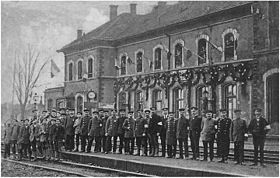Bénestroff train station
| Bénestroff | |
|---|---|
|
Bensdorf at the opening of the station, tracks 3–1 north side
|
|
| Data | |
| Location in the network | Intermediate station |
| Design | formerly Inselbahnhof |
| Platform tracks | 2, former 6 |
| IBNR | 8700557 |
| opening | 1885 |
| Architectural data | |
| Architectural style | historicism |
| location | |
| City / municipality | Bénestroff |
| Department | Moselle department |
| region | Grand Est |
| Country | France |
| Coordinates | 48 ° 54 '23 " N , 6 ° 45' 8" E |
| Height ( SO ) | 250 m |
| Railway lines | |
|
|
| List of train stations in France | |
Coming in from the Imperial Railways in Alsace-Lorraine erected Lorraine Station Bénestroff ( German Bensdorf ) had two main - and a branch line from its opening in 1885 until the 1950s, an important railway junction . The two double -track lines Metz – Strasbourg and Sarreguemines – Nancy intersected in it . In addition, the single-track railway line Bénestroff-Nouvel-Avricourt to Igney-Avricourt began here .
location
The track runs almost in an east-west direction when it was built on the northern edge of the town. Today parts of the city are still further north. The two main routes intersect at a rather flat angle coming from east and west, only the route to Avricourt ( German Elfringen ) is diverted to the west and then makes a wide bend around the city to the southeast.
Today the station is only served by line 21 (Metz – Strasbourg) with three TER Lorraine trains, the others go through without stopping.
The railway facilities and the train station, which was much too large in relation to the town, were designed in accordance with the infrastructure provided: In addition to the two house platforms , there was one on each route, i.e. a total of two additional island platforms. The tracks on the Metz – Strasbourg line to the north of the station had a through track and three parallel sidings, while the southern tracks on the Sarreguemines – Nancy line had six sidings in their best state of development at the beginning of the 1950s. On the opposite side of the route there was the freight loading siding with two additional sidings. A total of five signal boxes belonged to the Bénestroff operation point, which directed the various railway areas.
West of the station on the line towards Nancy were two turntables with a depot and several other sidings. Although this operating site was unusually far away from the train station, it was right next to the flyover structure that was required for changing lanes in the transition between different driving regulations in individual countries at the national borders. In this way, the track feed from and to the depot on both tracks could be carried out without crossing any further buildings. The responsible signal box No. 5 was also correspondingly large. As with Metz station , military functionality was the top priority for the construction of the smaller stations at the end of the cannon train in the deployment area before the First World War . The Bénestroff station served the two garrisons in Dieuze and Morhange .
building
The station building corresponded to the type station "Typ Bergfried" and is built entirely on two floors with a hipped roof; the hipped roof of the clock tower on the side was too high. Overall, the building was plastered differently than most of the other train stations built at the time, only the corners of the building were carved out as boss masonry . The station appeared squat and compact, although the main building was about 30 meters long.
The elongated station building located between the two lines had its entrance on the front side on which the clock tower was also positioned; the three clocks faced the two sides of the track and the small square in front of the station; The tower had no dial towards the roof. The main building has twelve axes, on the track side in the arrangement (east-west) 3-7-2 each, so that the building had an asymmetrical floor plan. The side elevations are intended for service rooms, the waiting rooms and ticket sales were arranged in the middle part. There were several service apartments on the upper floor. The house was demolished in October 2007.
accident
On Monday, March 23, 1924, at 2:02 am near the Bénestroff station, a serious railway accident occurred in which nine people were killed, 15 were injured, 13 of them seriously. According to historical press releases, the dispatcher on duty fell asleep. The express train Oostende – Basel was directed to the track where a coal train was supposed to wait for the overhaul. The locomotive with tender, the post carriage and two third-class passenger cars were thrown from the track and broke. The two Italian through cars at the end of the train remained undamaged.
Web links
- Picture of the station building (overall system) ( Memento from December 25, 2012 in the web archive archive.today ) |
- Description of the train stations in the EL area
- Picture of the train station shortly before its demolition
Individual evidence
- ^ Jean Buchmann: Track plan Bénestroff
- ↑ Jean Buchmann: Carte indiquant les numéros the Lignes au Embranchements
- ↑ SNCF timetable (PDF; 79 kB)
- ↑ picture of signal box no. 3
- ^ Jean-Georges Trouillet: Imperial Railways in Alsace-Lorraine (EL)
- ↑ http://etienne.biellmann.free.fr/gare/fr/Dieuze-Benestroff.htm
- ↑ Le Matin , March 25, 1924, pp. 1f
Remarks
- ^ Under French administration, this type of station was called "Type 12".


